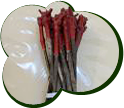Tel: (+33)2 41 52 20 63
Contact Us
This is a crucial decision as the rootstock characteristics should reflect vine sustainability and the wine grower’s objectives.
Many criteria should be taken into account:
- Chlorosis resistance
There are two ways to evaluate rootstock resistance to chlorosis:
- The first one from Drouineau and Galet showing the level of active calcium carbonate in percentage on a scale from O to 53, 53 representing pure chalk.
- CRI or Chlorosis-Risk Index which takes into account the level of active calcium carbonate Ca Co3 and extractable iron (Fe)².
Results interpretation :

- Water regime of the parcels
The root system of the rootstock should match local climate conditions. It must be resistant to drought periods as well as excess of rain even though moist soils do not seemed to be adapted to vine culture increasing risk of root hypoxia. In a case of a moist soil draining techniques should be reviewed.
- Soil acidity
Many rootstocks cannot bear acidity in the soil while others like Gravesac or Kober 5BB feel comfortable.
- Resistance to soil pest
Nowadays mainly all rootstock are resistant to phylloxera, however in sandy conditions nematodes can be sheltered which need to be checked.
- Yield objective
It seems rather important to take into account both soil fertility and rootstock’s vigor because overproduction happens when vigor is combined with fertile soil.
A vigorous rootstock favours high yields while fine wine requires weaker rootstocks. Vigor may lead to late ripeness which sometimes is not needed.




